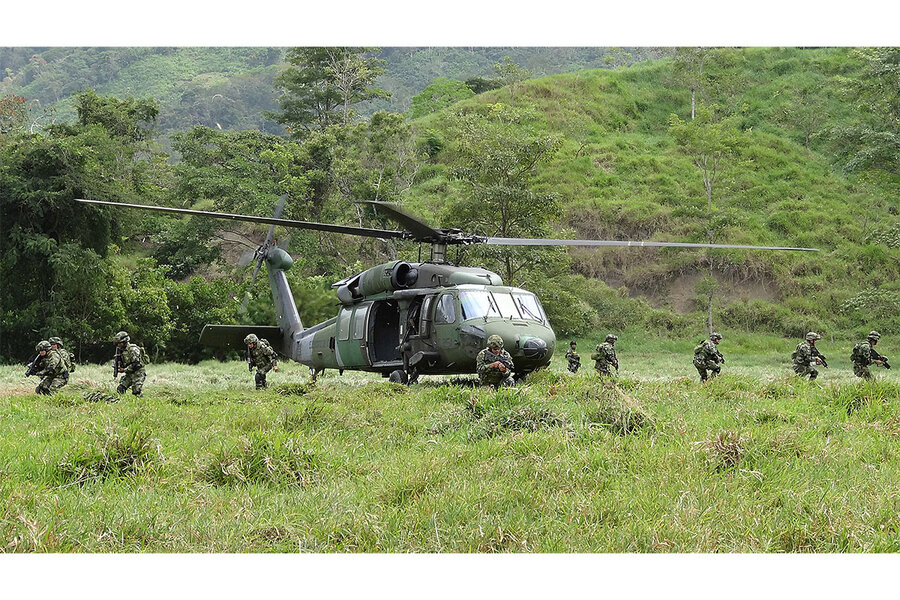Colombia opens ELN negotiations, another step toward lasting peace
Loading...
A version of this post ran on The Conversation. The views expressed are the author's own.
On Feb. 7, two months after signing a peace agreement with the Revolutionary Armed Forces of Colombia (FARC) guerrillas, the Colombian government is to begin formal negotiations with the country’s second-largest guerrilla group, the National Liberation Army, or ELN.
The group remains active, recruiting FARC deserters and co-opting areas relinquished by the FARC, including the Chocó, Santander, and Arauca departments. Though the ELN has weakened over the past decade, it is still estimated to have around 1,300 soldiers – compared with the roughly 6,500 the FARC were able to muster at last count.
A successful agreement with the ELN, which is more a clandestine political organization than a FARC-esque military body, is a necessary next step in ending the country’s 50-year civil war.
The negotiation process also allows the government to consider new peace-building responses for Colombia. ELN-dominated regions have faced different kinds of violence than that exerted by the FARC. Whereas the FARC attempted to contest and replace the state in areas under its control, the ELN attempts to co-opt and manipulate existing institutions while seeking the support of local social movements.
In that way, by helping the government to better grasp the complexity of Colombia’s conflict, the ELN negotiations make a lasting peace more feasible. They may also serve to sharpen the international perception of what’s often generically labelled “the Colombian conflict.”
Much English-language news coverage of Colombia’s war, and the recent peace process, have presented a simplified narrative focused on a single dominant actor (the FARC) and its high-profile attacks and kidnappings. But a jumble of actors – each with different, and often competing, interests – have waged this 50-year war: drug cartels, paramilitaries, private armies, and left-wing guerrillas. Thus, despite being one of the world’s oldest armed insurgent groups, the ELN is little-known outside Colombia.
Founded in 1964 by Cuba-trained university students, the guerrilla organization has sought a Colombian version of Fidel Castro’s revolution. Because its discourse centers on state sovereignty and social justice (it has often railed, for example, against multinational companies that get rich exploiting Colombian minerals and gas) the ELN has been responsible for fewer bloody civilian-oriented bombings and massacres than the FARC.
Instead, it has preferred to sabotage infrastructure, such as oil pipelines. For example, in 1998, the ELN attacked the Cusiana-Coveñas oil pipeline, killing more than 80 civilians. The group is also involved in drug trafficking, especially the transport and taxation of drugs. Over the past four decades, the ELN has been responsible for more than 6,000 kidnappings and 1,900 assassinations.
Colombia’s complicated conflict
The existence of multiple armed groups in Colombia reveals the many difficulties the country’s state institutions have experienced in imposing law and order over a rugged land where specific interests have managed to undermine national goals.
The state has failed to guarantee the rights of small landowners, allowing large landholders, politicians, well-connected businessmen, and drug traffickers to steal or expropriate large swaths of peasant farmland. Nor have security forces achieved a monopoly of violence across the whole country, which is widely recognized as a defining characteristic of the modern state.
As a result, for four decades the FARC, ELN, and other outfits – be they guerrillas, right-wing paramilitaries, drug lords, or warlords – have claimed to represent the interests of “the citizens.” They have maintained parasitic relationships with local governments, either replacing or unduly influencing how the state delivers justice and authority.
For Colombia to actually end its war, it must not only find a way for the ELN and FARC movements to join Colombian politics by peaceful means but also determine which of these other armed groups are considered eligible for further peace processes.
Should drug lords, warlords, and paramilitaries, which continue to displace the state in different parts of the country, be next? If they are indeed now controlling areas previously run by the FARC, can Colombia achieve a real peace without bringing them to the negotiating table? Or should they be defeated by the might of the state?
These are thorny questions that demonstrate why peace building must go beyond the FARC accords. To inform policies and strategies that could help Colombia meet its many challenges, the government of President Juan Manuel Santos must leverage the ELN talks to help recognize and learn from the institutional failures that have spawned these armed groups.
Peace at last with the ELN?
This is the ELN’s fourth official attempt to negotiate with the Colombian state. With its more horizontal and decentralized structure, and because revolutionary dissent is an ELN objective, the group is considered to be more “stubborn” than the FARC. As such, it is difficult to predict the outcome of this upcoming peace process.
It is expected to be different than the four-year-long FARC negotiations, which were often perceived as an elite-to-elite conversation. With the ELN, civil society, including environmental organizations and trade unions that share some of the group’s views, will have a voice in the peace process. This will enable a wider-ranging national negotiation that could, in turn, strengthen and reinforce the existing FARC agreement by supporting a broader peace-building exercise.
Still, a peace agreement is not peace; it is a roadmap for how to arrive at peace. If Mr. Santos succeeds in negotiating and signing a peace accord with the ELN, it would be a momentous achievement. But it would mark the beginning of another journey for Colombia, not an arrival.
Fabio Andres Diaz is a research associate at the department of political and international studies at Rhodes University in South Africa and a researcher at the International Institute of Social Studies in the Netherlands.







